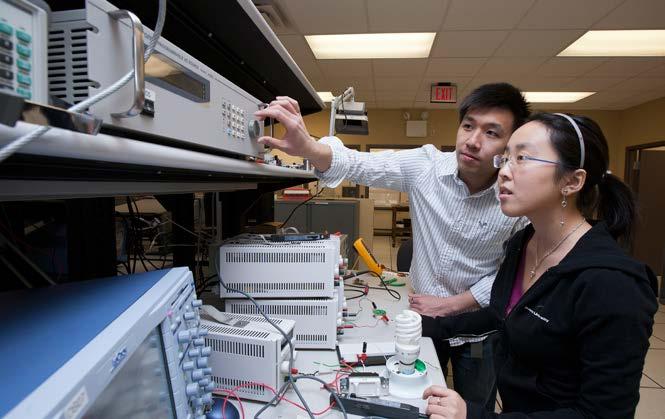
3 minute read
ePOWER-ing the future
ePOWER is home many talented graduate students.
Maximizing how much solar power can be captured. Improving the efficiency of wind turbines. Working on electric cars that could give power back to the grid.
Advertisement
These are just a few of the myriad projects underway at the Queen’s Centre for Energy and Power Electronics Research (ePOWER). Located in Walter Light Hall, ePOWER specializes in new ideas to make power greener.
Director Dr. Praveen Jain, the Canada Research Chair in Power Electronics, looks pleased as he shows off the future site of ePOWER’s renewable energy lab,

to be up and running by fall 2016.
“This area was dark, cluttered and filled with things people didn’t need,” says Dr. Jain. Now, the renovated, bright space is lined with windows and ready for researchers to move in. “Our next step is the wind turbines and solar panels, which will be installed upstairs on the rooftop.”
The creation of the renewable energy lab, funded by a Canada Foundation for Innovation grant of $1 million, is particularly exciting, Jain says. “Our lab now can provide various solutions, but when it comes to renewable energy, whatever you do, systems need to be connected together.”
Interaction between the traditional grid and smart grids is needed. “For that, we need actual wind turbines, actual solar panels, so we can connect them together and see how everything is performing.”
With it, the new lab brings the promise of pioneering discoveries in renewable energy. Jain, renowned for his groundbreaking work as an electrical engineer, has already donated 55 patents to the university and has founded two startups, CHiL Semiconductor and SPARQ Systems.
A previous facilities milestone was reached in 2004, when a Canada Foundation for Innovation grant enabled Dr. Jain to bring together ePOWER’s facilities, a big improvement for its 50 active researchers, which include students. Six distinct areas were linked: a computer-aided design lab, a hardware lab, an electromagnetic interference lab, a magnetics and printed circuit board lab, a silicon integration lab, and a renewableenergy test platform.
“We are unique in this way: other universities don’t have such integrated facilities,” Jain says. As well, the wide range of applications for ePOWER’s work is unusual. “Our research can be used in aerospace, for electric vehicles and for data transmission, for example.”
Equipment/features list:

Renewable Energy Lab Magnetics and PCB Lab Silicon Integration Lab
Do you have an aspiring engineer in your family?
If your child is entering grades 10 through 12, you can give them an introduction to the Queen’s Engineering experience with EngAGE, the Queen’s Engineering Academy Guided Experience!
With both residence and day options available, EngAGE is an engineering-focused educational summer program that exposes your child to the main engineering fields of chemical, civil, electrical and computing, and mechanical engineering.


The academy is two weeks long and covers the main engineering disciplines. A single week option is also available.


EngAGE presents students with a broad engineering overview, using lab facilities and thought-provoking projects to inform and engage students without being technically overwhelming. The team-based design projects that your child will collaborate on incorporate leadership skills and are based on the same basic concepts and methodologies Queen’s engineering students study.
The residence program includes: on-campus residence with three meals/day, full-time supervision and supervised activities each evening. The day program includes lunch. The program runs from July 18 to August 19.










